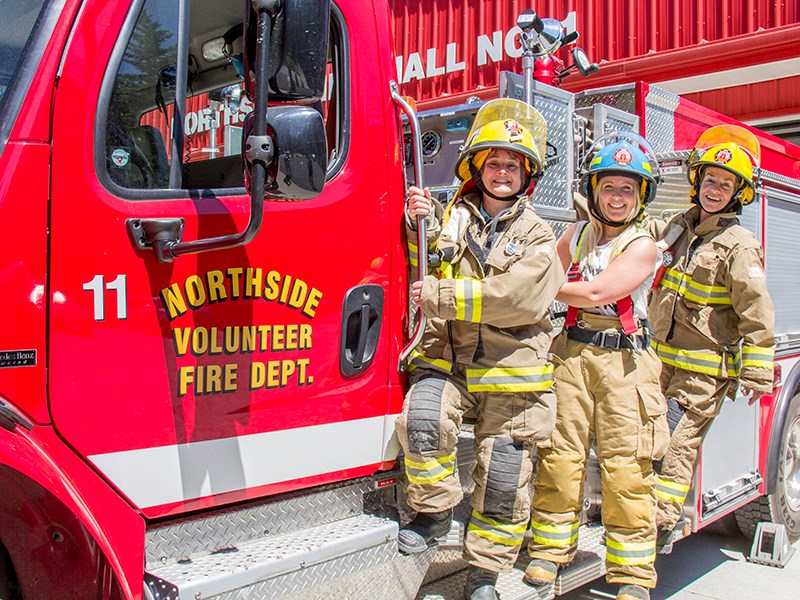On call 24 hours a day, volunteers of Powell River region fire departments are first in and last out at scenes of fires, accidents and medical emergencies.
According to the firefighters, they train and carry the same responsibilities as those in big cities, and there is always that initial emergency call.
When she started as a volunteer firefighter, Kimberly Burge said there was no warning before she was called to the line for the first time.
“I’ve been down in the belly of two forest fires,” said Burge. “It was a little scary at first. I wasn’t expecting they were going to send me down there, but I showed up and they gave me a hose and sent me down into the fire.”
Fellow volunteer firefighter Ann Snow said there are so many safety issues and regulations that firefighting is not dangerous.
“I have never been on a call where I felt I was in a dangerous situation,” said Snow. “We train for safety first, how to use our gear and equipment, and how to identify problem areas and issues; the safety issue is first.”
Snow’s first experience was responding to call and being the first on the scene by about 15 minutes.
“It was a car fire in the Okeover area,” she said. “I managed to get the fire under control all by myself. The car was completely gone, but when you get something that’s fully involved like that, you just go into containment mode.”
In order to fulfill obligations to the communities they serve, volunteer fire departments are in a constant struggle with financial, staffing and emotional pressures.
On Wednesday, May 25, Van Anda and Gillies Bay volunteer fire departments joined forces to fight a fire that destroyed the Texada Island Inn.
According to Van Anda’s fire chief Mike Craggs, it was a particularly difficult call because of the destructive extent of the fire and the importance of the inn for such a tight-knit community.
“It’s a place we all hang out at, so it affects us all. However, we’re trained to put that stuff aside and just deal with the issue,” said Craggs. “We try to separate our personal worries from our professional worries.”
In small communities served by volunteer fire departments, more often than not, members will be responding to calls involving a friend or neighbour.
“Many times I have been on call where I knew the person,” said Snow.
Major challenges facing Powell River region fire departments include finding volunteers, funding for equipment costs, such as gear for the firefighters, acquiring fire trucks that can cost upwards of $0.5 million, and the mental and physical health costs
suffered by first responders.
Northside Volunteer Fire Department captain Brian Fahey became a volunteer more than 25 years ago. At the time, the department consisted of only Fahey and one other member.
“When I started here we didn’t have money to pay electricity for the hall or have the truck certified or fueled. We were using gear from other departments,” said Fahey.
According to Mac Gregory, executive director of Volunteer Firefighters Association of BC (VFFA), all small fire departments are underfunded.
“There’s a huge variety of funding levels, from private fire associations that have garage sales to raise money to those that are funded by regional districts,” said Gregory, who added that some are funded by water boards and others receive funding municipally.
Gregory said not only are these small fire departments underfunded, they are often lacking volunteer numbers.
“The turnover in some places is quite high,” said Gregory. “A number of volunteer halls around the province continually have signs up looking for volunteers.”
Craggs said it is exceptionally hard to fill volunteer ranks for a number of reasons.
Van Anda’s department has 18 members; the minimum number required for a functioning fire department is 16. Eventually, Cragg said, the job gets to just about everyone and the burnout rate for a volunteer firefighters is about five years. Van Anda has lost a couple of members because of post-traumatic stress disorder (PTSD), he said.
“Mental issues hit every volunteer; it tends to start kicking in at about the five-year mark,” said Craggs. “If you get past five years, you can shut your emotions off enough to handle the situation. The trouble is, on a small island like this, everybody knows everybody else and you’re dealing with friends and neighbours or immediate family.”
Gregory said he has personally experienced PTSD.
“I was a school teacher and a volunteer firefighter, and I had a student-teacher in my classroom,” said Gregory. “I responded to an incident where someone in a car accident was killed. I was on scene for an hour before I recognized his vehicle and that it was him.”
On Texada, Craggs holds a debriefing with his entire crew immediately after a fire or a situation requiring a first response, and counselling is offered when needed.
VFFA and WorkSafe BC are continuing to work on counselling protocols.
More than 20 years ago in Castlegar, BC, when Gregory had his traumatic experience, he said there was no support available to him.
Back then, Gregory said he felt he only had one person he could talk to.
“Just with my wife,” he said.
For more information on becoming a volunteer firefighter, go to fire protection services at powellriverrd.bc.ca



